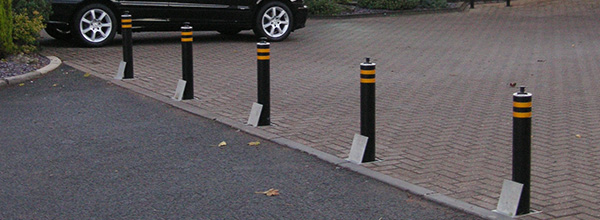Bollards
Security bollards protect vulnerable building areas
Security bollards act as both a physical and visual barrier. They are varied in their shapes, sizes, and designs. Bollards and security barriers protect lives and property by creating a controlled traffic setting. Knowing the differences between types of bollards will help to select the best post for a site.
Impact protection isn’t the only factor to consider. Perimeter barriers should avoid unwanted clutter and bother for visitors. Unlike other types of barriers, such as fences or large concrete blocks, security bollards can restrict vehicle access while allowing clear pedestrian flow.

Each building and property has several common risk factors to consider. Besides security, thorough design strategies must also review surrounding aesthetics and access needs.
What are your security needs?
Security barriers create physical and psychological deterrents to unauthorized entry. When planning effective building safety, it’s important to assess the scope of risks and vulnerabilities. In other words, it is important to know what requires protection, what are the potential risks and threats, and which areas are most vulnerable.
Threat factors to consider
Local traffic threats must be examined when deciding on impact protection
Erratic vehicles can cause untold damage upon impact with a building—not to mention the risk to pedestrians and occupants. Therefore, it is important to consider the surrounding driving environment to understand how a building and its occupants may be threatened.
- Access and proximity to traffic – How close do vehicles get to the building or other sensitive areas? Consider public streets, onsite roads, and parking lots.
- Traffic frequency – Is the site located in a high-traffic area? Greater vehicle activity can increase the likelihood of an accident.
- Speed of nearby vehicles – Speed is an important factor to consider. Higher speeds reduce driver reaction times and increases vehicle momentum, which in turn, increases the damage potential.
- Types of traffic – There are a variety of vehicles out there, such as cars, trucks, bicycles, and scooters. Vehicle mass should be considered, as there is a big difference in the amount of damage a bike can do compared to a semi-trailer truck. A one-ton truck has several times the mass than a small compact car, meaning the damage it causes is proportionally multiplied as well.
- Building and road orientations – Consider the whereabouts and direction of nearby traffic. Does it traverse alongside the building or property? Or does it flow directly at a storefront entrance? Long, unobstructed run-ups can increase risk, as they allow vehicles to build up more speed. Downhill trajectories can also reduce braking effectiveness. Roads are not the only potential hazard. Nose-in, or front-in, parking orientations can be dangerous, as a simple pedal or shifting error could send vehicles flying into buildings.
- Driver behavior – Are drivers typically in a rush when near the building? What does the surrounding environment look like? Is it busy and full of distractions? Seasonality can also be a factor here. A beachfront restaurant will see a lot more traffic during the summer, while winter road conditions are a hazard, especially on hillsides.

Securing against crime
Vehicle ram-raids are also a security concern for stores. During these invasions, thieves crash a vehicle directly into a building to gain access, threatening the safety of employees and customers. If a collision occurs while the building is occupied, the resulting debris and the vehicle itself can cause injuries or fatalities. The damage caused is often significant, requiring extensive time and money to repair.
Terrorist attacks are also a threat for high-profile buildings and locations, such as government or financial buildings, or buildings that accommodate a large number of people. According to the NYPD, other areas near these types of locations also have increased risk—buildings in dense urban environments must consider their vulnerability to acts of terrorism. The use of explosives or vehicle ramming attacks are common methods of terrorist attack. Perimeter protective site security design can help increase protection against intentional site attacks.
Risk and vulnerability—what’s at stake?
Once potential threats to a site are recognized, steps can be taken to install proper security measures. Certain areas on site, such as large storefront windows and entrances, are key areas to evaluate. When unprotected, they can be especially vulnerable to oncoming traffic. Building corners and other external structures, such as utility boxes, fire hydrants, and storage areas, are also often overlooked. A building corner and other external structures are more subject to impact, as their position makes them more likely to be at risk from collision with heavy objects, vehicles, and unwary or malicious pedestrians.

Site security usually revolves around the protection of the building itself. However, it is important to not overlook the people who occupy it. A building’s security measures are vital in securing the safety of its occupants, visitors, employees, and customers.
Insurance may cover the financials of a building crash, but there are other problems to consider. When a vehicle collides with a building, the damage can cause temporary store closure, or injuries to employees and customers.
The repair process can also have a negative impact on nearby businesses. People may perceive the location as unsafe, and choose to avoid it. Less parking spaces, construction clutter, and noise pollution often result during the repair process. Additional temporary security measures, such as security guards, are often required during the repair as well.
Crash bollards for perimeter protection: Rated vs un-rated
Once a structure’s vulnerable areas are identified, and potential threats considered, a perimeter security plan can be designed. The plan should consider what needs to be protected, and it should select what type of barriers are required.
Crash-rated bollards
Security bollards with iron decorative covers protect a building perimeter
For high-security applications, or in locations where there are both high-risk and high-threat factors to consider, crash-rated bollards may be needed. For products to be certified under one of these rating systems, they must be live tested at an independent crash test facility under specific and controlled conditions. There are two industry standards for crash ratings:
- K-ratings. K-rated standards were originally developed by the US Department of State (DoS) in 1985 and then revised by the DoS and the Department of Defense (DoD) in 2003. For bollards to pass live testing, they need to withstand an impact from a 15,000 lb payload without exceeding set penetration distances. Bollards are rated based on the vehicle speeds they can stop: K12, K8, and K4 for 50 mph, 40 mph, and 30 mph respectively.
- ASTM standards. The American Society for Testing and Materials (ASTM) has developed its own standard, based on DoS and DoD criteria, that incorporates different vehicle types and ratings based on vehicle penetration. It has created separate standards for small passenger cars (2,430 lbs), pickup trucks (5,070 lbs), medium-duty trucks (15,000 lbs), and heavy goods vehicles (65,000 lbs).
Crash-rated barriers provide the most secure protection, but they are very expensive to purchase and install. The most basic crash-rated installations can cost tens (if not hundreds) of thousands of dollars. Other features, such as retractability and automatic deployment, also require significant, ongoing maintenance and care to ensure barriers remain operational.

Un-rated crash bollards
Protective plastic covers increase visibility of security bollards
Un-rated barriers provide a more cost-effective solution than crash-rated products, while still providing significant impact protection.
Steel pipe security posts offer the most basic form of impact protection. Often referred to as “bumper posts,” they should be embedded deep into the ground and reinforced with concrete to provide a high level of impact protection. A basic installation for a set of steel pipe security bollards can be quite cost-efficient.
Effective security does not have to come at the expense of functionality or design.
For locations where design and aesthetics are important, basic steel pipe security posts can be covered with either cost-effective plastic sleeves or decorative metal covers to enhance their visual appeal, and also to protect from wear and corrosion. Effective security does not have to come at the expense of cost or design.
All bollards (rated or not) create visual barriers that identify sensitive areas for vehicles, and deter ram-raid invasions. For areas with lower risk, simple bolt-down bollards, decorative posts, flexible bollards, and removable columns are often used to encourage slower, more responsible driving.
Recommendations
When planning site security, it is critical to assess security needs and the range of options that are available—from precisely-measured impact resistance to more economical options. Other factors such as traffic control and aesthetic design should also be considered.
The most effective security installations include a range of potential stakeholders and knowledgeable experts to assess the needs of a specific site, and to find the most optimal solutions. Improper planning can lead to poor functionality, which can be costly or near-impossible to fix or replace. Consequences of a failed barrier can be disastrous.
